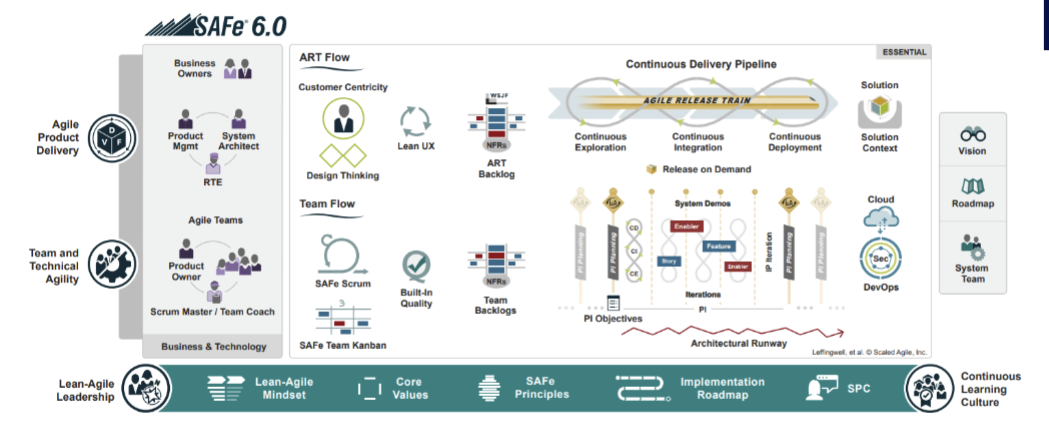Scrum at Scale - SAFe (Scaled Agile Framework)
Project Assumption: CareConnect+
- Background You are working on a government-funded initiative to develop a digital health platform that will serve patients, hospitals, doctors, and pharmacies.
- Integrated Modules:
- Patient Portal: App for appointment booking, prescriptions, and health records
- Hospital Dashboard: Real-time bed availability, emergency triage, and admin controls
- Doctor Portal: Integration with Electronic Health Records (EHRs), consultation tools
- Pharmacy System: Inventory management, drug availability tracking, and refill services
- AI-Powered Insights: Predictive analytics for early diagnosis and resource planning
- National API Gateway: Integration with third-party systems and health insurance providers
- Estimated Delivery Time: 18 – 24 Months in Phased Releases
- Potential Issues
- These are the kind of projects we do in the industry, right ?
- Is this project even doable by a 5 – 10-member Scrum team? Nah !
- How do we coordinate work across multiple teams working on different modules of this project?
- Who ensures that the product vision stays aligned across all teams?
- How are architectural decisions made and shared?
- What if different teams have dependencies on each other’s outputs?
- How do we plan and prioritize features at a program level, not just a team level?
- Who resolves issues that are beyond the control of individual Scrum teams?
- Can a single Product Owner handle all these requirements?
- How do we ensure regular, integrated delivery when so many teams are involved?
Essential SAFe
helps scale Agile practices across multiple teams working on large, complex products.
It brings together Agile, Lean, and DevOps principles.
Essential SAFe focuses on the Agile Release Train (ART) – Virtual team of 5–12 Agile teams delivering value together.
Key events
- Program Increment (PI) Planning – Teams plan together every 8–12 weeks.
- System Demo – integrated product demo from all teams at the end of each iteration.
- Inspect & Adapt Workshop – Teams reflect and improve at the end of each PI
Key Roles:
- Release Train Engineer (RTE) – Like a “Super Scrum Master,” coordinating the ART.
- Product Management – responsible for features and prioritization across the ART.
- System Architect/Engineer – ensures technical alignment across teams.
- Emphasizes alignment, collaboration, and synchronized delivery across teams
Benefits
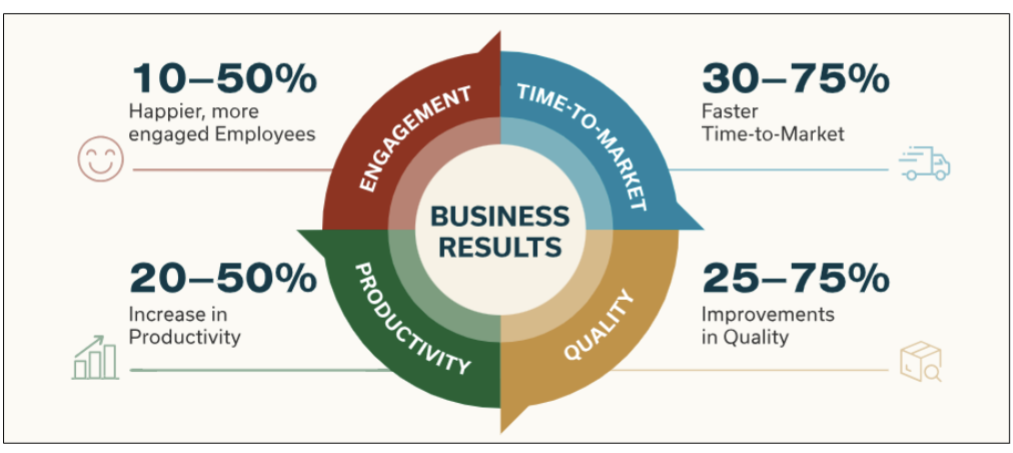
Why Scrum is not enough at scale
- Scrum works great for a single cross-functional team (5-9)
- But as teams grow
- Dependencies increase.
- Alignment across teams becomes difficult.
- Shared architecture and delivery timelines need coordination.
- SAFe fills these gaps in scaling, while preserving Agile values.
SAFe
Roles and Responsibilities
- Agile Release Train (ART) – Roles
- Release Train Engineer (RTE) acts as Chief Scrum Master for the train
- Product Management owns, defines, and prioritizes the Program Backlog
- System Architect provides architectural guidance and technical enablement to the teams on the train
- Business Owners are key Stakeholders on the train to ensure the value delivered by the ART meets customer and organizational needs
- Team Roles
- Scrum Master facilitates team Scrum events, removes blockers, and supports Agile practices within the team
- Product Owner owns the Team Backlog. Defines and prioritizes User Stories. Aligns with Product Management.
- Agile Team delivers working software every iteration. Breaks down Features into Stories and estimates effort.
Key area iof Essential SAFe
Product Increment (PI) Planning
A collaborative event where all teams in the Agile Release Train (ART) work together on a shared plan.Agile Release Train (ART)
A team of Agile Teams (50–125 people) working together to deliver value in a synchronized manner.SAFe Roles and Responsibilities
Key roles include Release Train Engineer (RTE), Product Management, System Architect, Scrum Master, and Product Owner.Dependency Management (Scrum of Scrums)
A mechanism to coordinate work and resolve dependencies across multiple teams.Program Backlog
Contains prioritized features that guide the work of the ART during a Program Increment (PI).System Demonstration
A regular event where teams demonstrate the integrated work completed during the iteration to stakeholders.Inspect and Adapt (I&A) Workshop
A structured event at the end of the PI to review progress, identify improvements, and plan for the next increment.
Product Increment (PI) Planning
- PI Planning is a regular, timeboxed event
- (usually every 8–12 weeks; 10 weeks is common).
- All teams in the Agile Release Train (ART) plan together—preferably in person.
- Product Management decides the priority of features.
- Agile Teams break features into stories and estimate the effort.
- System Architects/Engineers guide technology decisions and help manage dependencies
- Program Level Calendar
- PI Planning Sessions
- System Demos
- Inspect & Adapt Workshops
- Team Level Activities
- Iteration Planning
- Iteration Reviews
- Iteration Retrospectives
- Features
- A Feature is a service or capability valuable to the user.
- Includes a Benefit Hypothesis (why it’s worth doing) and Acceptance Criteria (what makes it done).
- Product Management defines and prioritizes features.
- Features include both functional and non-functional needs.
- A feature should be delivered within a single Program Increment.
- Scenario Assumption
- Feature : Personalized Course Dashboard
- Benefit Hypothesis: Providing students with a personalized dashboard will improve course engagement and reduce confusion about deadlines and resources, leading to better academic performance
- Acceptance Criteria
- Students to be able to see list of enrolled courses
- Upcoming Assignment Deadlines highlighted per course
- Dashboard loads under 3 seconds both for web and mobile interfaces
- Customization support with widgets that students can choose
Agile Release Train
- Virtual Organization of about 5 – 12 teams (about 50 – 125 individuals) that plans, commits, and executes together
- Program Increment (PI) is a fixed timebox. Default is 10 weeks
- Typically consists of 4 – 5 Iterations
- Synchronized Iterations and PI's
- All teams work on the same cadence to ensure alignment / coordination
- Aligned to a common mission via a single Program Backlog
- Operates under architectural and UX guidance from System Architect
- Frequently produces valuable and evaluable System Level Solutions, demonstrated during the System Demo
- Identifies and manages Dependencies between teams for smooth delivery of value
- Facilitated by the Release Train Engineer (RTE), who ensures alignment across teams
Dependency Management
- Managing Dependencies across teams
- In large programs, multiple Agile teams work together toward a common goal.
- Teams often depend on each other to complete features or share components.
- Unmanaged dependencies lead to delays, rework, or integration issues.
- SAFe uses structured events like Scrum of Scrums (SoS) to coordinate across teams.
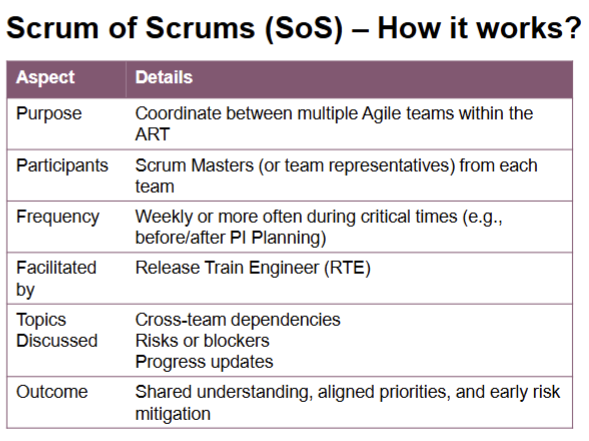
Program Backlog
The Program Backlog is the single source of truth for upcoming work at the Agile Release Train level.
It contains Features (not individual User Stories) prioritized by Product Management.
Features represent larger functionalities valuable to users or customers.
Each Feature includes:
- Benefit Hypothesis – why the Feature is worth building
- Acceptance Criteria – how to know it's done
Owned by Product Management
Typically spans across multiple Program Increments
Why is it important?
- Aligns all teams on the Agile Release Train (ART) with a common set of priorities.
- Drives PI Planning – Teams select Features from this backlog for implementation in the next Program Increment.
What happens to Features?
- Broken down into User Stories during PI Planning.
- Stories are distributed across teams based on capacity, expertise, and dependencies.
Helps to answer:
- What should we build next?
- What features delivers the most value to customers?
System Demonstration
- All the teams in an Agile Release Train (ART) come together to demonstrate the integrated work they have completed during the Program Increment (PI).
- This event shows how the features delivered by all the teams are integrated into a working solution.

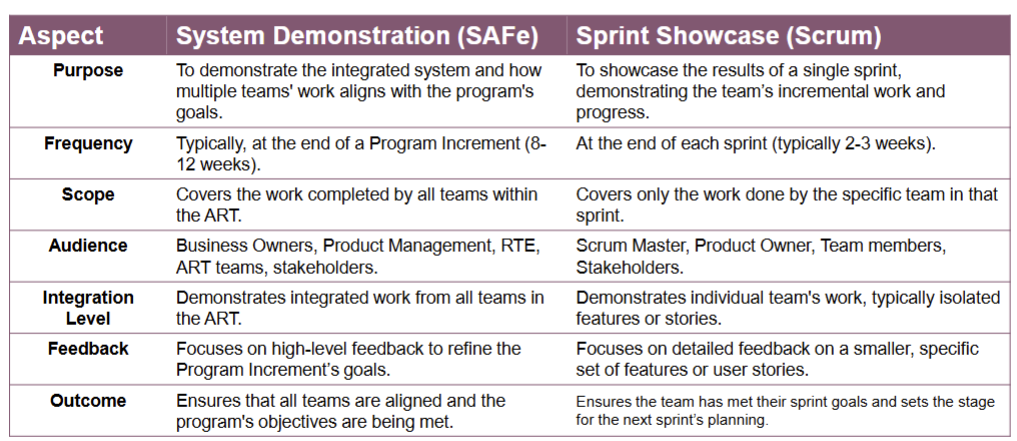
Inspect and Adapt (I&A) workshop
- Key event in SAFe held at the end of each Program Increment (PI).
- Provides an opportunity for the entire Agile Release Train (ART) to reflect on the PI’s progress, identify areas for improvement, and adjust their approach going forward.

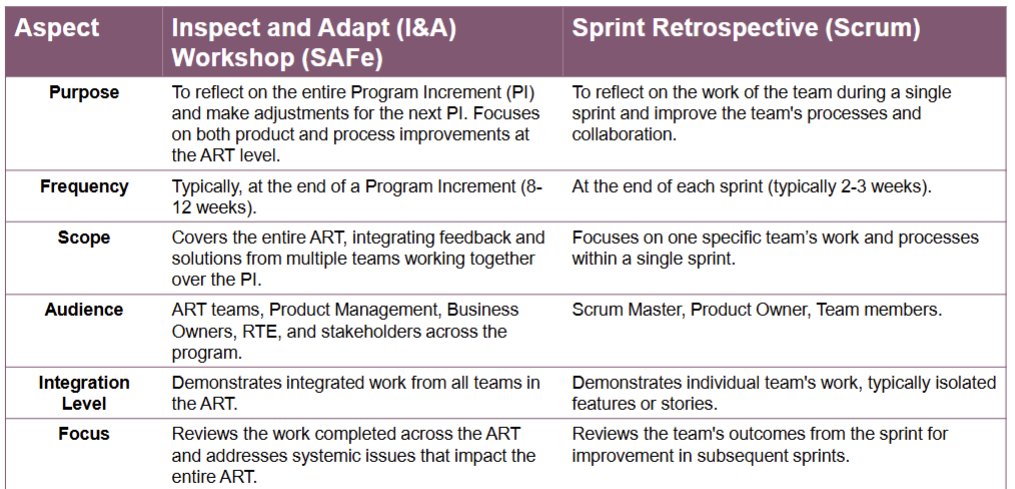
Summary
🧩 Core Concepts
ART (Agile Release Train)
A team of Agile teams (typically 5–12) that delivers value together in a synchronized cadence.PI (Program Increment)
A timebox (usually 8–12 weeks) during which an ART delivers incremental value in the form of working, tested software and systems.PI Planning
A two-day cadence-based event where all ART teams align on a shared vision and commit to delivery goals.Product Management
Defines and prioritizes Features in the Program Backlog; works with teams during PI Planning.Feature
A service or capability that fulfills a stakeholder need; fits within a PI and is decomposed into Stories.User Story
A small, testable unit of work that fits into one Iteration (Sprint); delivers part of a Feature.System Demo
An integrated demonstration of new functionality from all teams at the end of each iteration or PI.Program Backlog
A prioritized list of Features intended to be implemented by the ART over upcoming PIs.Scrum of Scrums
A coordination meeting where team representatives (often Scrum Masters) discuss cross-team issues.Inspect & Adapt (I&A)
A workshop held at the end of each PI to reflect, measure outcomes, and drive continuous improvement.
👥 SAFe Roles
Release Train Engineer (RTE)
Facilitates ART events, removes cross-team impediments, supports coordination and delivery.Product Management
Owns and prioritizes the Program Backlog; defines and prioritizes Features across teams.Product Owner (PO)
Works with one Agile team; owns the Team Backlog and defines User Stories.System Architect / Engineer
Provides architectural guidance and helps teams align with enterprise standards.Business Owners
Key stakeholders who have authority and accountability for business outcomes of the ART.Scrum Master
Supports a specific team; facilitates team-level ceremonies and removes local blockers.Agile Team Member
Developers, testers, designers, etc., who collaborate to build and deliver Stories and Features.
